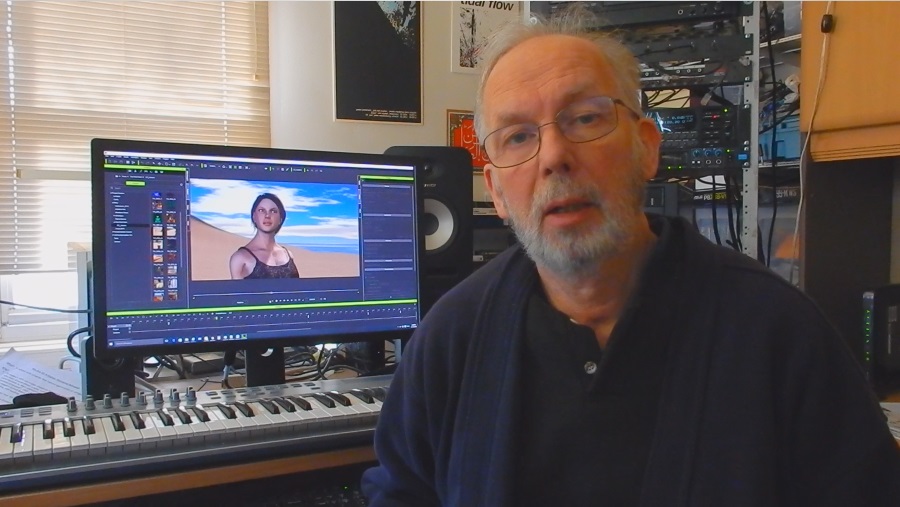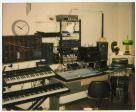studio
the importance of a private work place
I have always maintained my own work area to realize my electronic compositions. Initially, this would just be a corner of my bed room. Later I was able to reserve a dedicated space in my residence and set up something that could be called a ‘studio’.
The reason for having a private studio is that institutional studios are only available at certain hours of the day and often require an affiliation, which I didn’t have most of the time. Imagine a painter or sculptor who is forced to create at preset hours...
My own space also allowed me to work with equipment of my own design, which would have been impossible in an institutional studio.
current status (2020)
Entering the 21st century, the studio has graduallly been made suitable for computer animation production. The music is now generated through software. Any remaining hardware synthesizers (except for a rack-mounted Kurzweil) have been retired.
The year 2018 saw the establishment of a larger studio premises in Front Royal, VA; details to follow.

brief history
before 1979
 In
the early days I didn’t really have a studio; it was rather kind of
a lab in my parents' attic, where I would build various kinds of
devices to produce or transform sound. In 1971, though, I could
purchase a professional-grade recorder; a Revox A77. I also built an
electronic piano/organ from a kit, which I used in the score for the
animated short Troost, my first published electronic
composition (1976).
In
the early days I didn’t really have a studio; it was rather kind of
a lab in my parents' attic, where I would build various kinds of
devices to produce or transform sound. In 1971, though, I could
purchase a professional-grade recorder; a Revox A77. I also built an
electronic piano/organ from a kit, which I used in the score for the
animated short Troost, my first published electronic
composition (1976).
1979 - 1985
 In
the summer of 1979, I moved to a large loft at Oudenoord in Utrecht
and was able to set up my first proper studio. This was an analog
tape studio with some equipment I had built myself and some
prototype Synton equipment. The Oudenoord studio was a great creative environment
where most of my purely analog pieces came into existence. I was a
student during that period, which gave me plenty of time to devote
to my music. Those were the days...
In
the summer of 1979, I moved to a large loft at Oudenoord in Utrecht
and was able to set up my first proper studio. This was an analog
tape studio with some equipment I had built myself and some
prototype Synton equipment. The Oudenoord studio was a great creative environment
where most of my purely analog pieces came into existence. I was a
student during that period, which gave me plenty of time to devote
to my music. Those were the days...
1985 - 1988
 Unfortunately,
I had to leave my large loft in 1985, but I was able to purchase a
small townhouse (one floor and an attic above the storage space of a
grocery store). I reserved a corner of the attic as studio. It was a
tight setup, but workable. I acquired my first MIDI equipment: an
Ensoniq ESQ-1 and a
Mirage rack-mount. I also bought an
Atari 1040,
which had a MIDI interface built in. As sequencer software I used
eMagic Notator, Logic’s predecessor. All this resulted in a move
away from the analog electronic music I had created before.
Unfortunately,
I had to leave my large loft in 1985, but I was able to purchase a
small townhouse (one floor and an attic above the storage space of a
grocery store). I reserved a corner of the attic as studio. It was a
tight setup, but workable. I acquired my first MIDI equipment: an
Ensoniq ESQ-1 and a
Mirage rack-mount. I also bought an
Atari 1040,
which had a MIDI interface built in. As sequencer software I used
eMagic Notator, Logic’s predecessor. All this resulted in a move
away from the analog electronic music I had created before.
1988 - 1993
 In
the fall of 1988 I bought a much larger house and could improve the studio
facility. As far as I can remember, I added a TEAC X-1000M two-track
recorder and a rack-mounted mixer to the equipment. Although I had a
better studio, I have the feeling that my professional career, which
was not in music, stood in the way of my compositional activities...
In
the fall of 1988 I bought a much larger house and could improve the studio
facility. As far as I can remember, I added a TEAC X-1000M two-track
recorder and a rack-mounted mixer to the equipment. Although I had a
better studio, I have the feeling that my professional career, which
was not in music, stood in the way of my compositional activities...
1993 - early 2000s
 In
1993 I moved to the United States and had to leave some of my equipment
behind, including several tape recorders. I did keep my Mirage, my
ESQ-1, and my Synton 3000, but added several digital sound modules.
I also started to use more and more software synthesis.
In
1993 I moved to the United States and had to leave some of my equipment
behind, including several tape recorders. I did keep my Mirage, my
ESQ-1, and my Synton 3000, but added several digital sound modules.
I also started to use more and more software synthesis.
21st century
 Currently all sound generation is through software, while the studio's
emphasis is on creating 3D animation, with the "sound section"
playing a supportive role.
Currently all sound generation is through software, while the studio's
emphasis is on creating 3D animation, with the "sound section"
playing a supportive role.
External links were up-to-date as per per January 26, 2023, but are subject to change beyond my control. Non-secure links have been removed.
